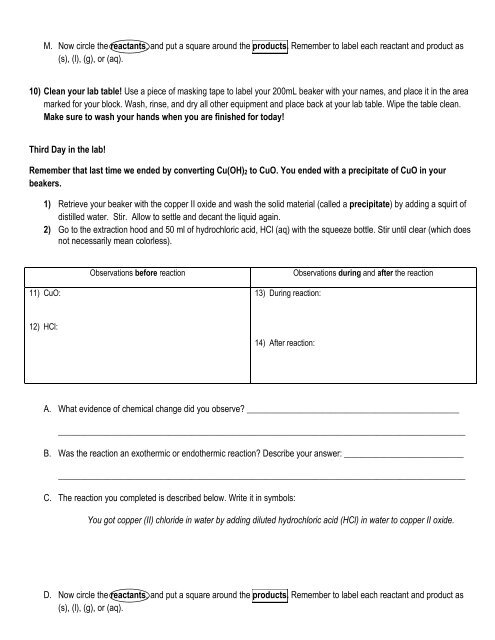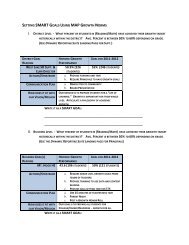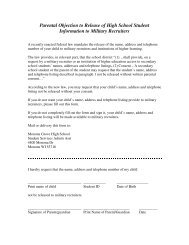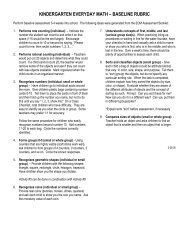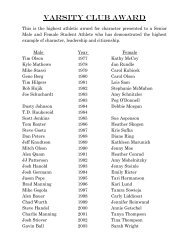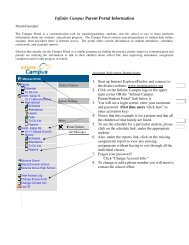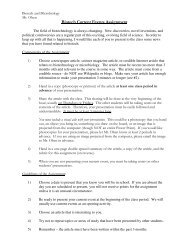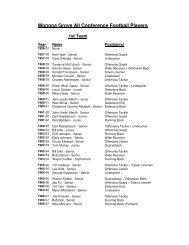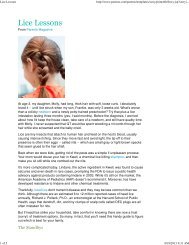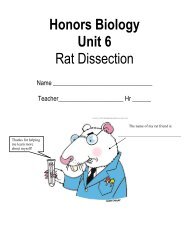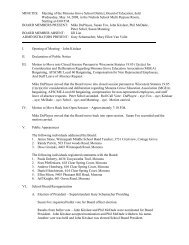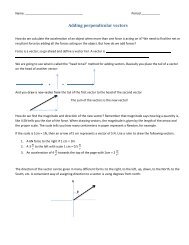Packet for Cu lab, naming and writing formulas, reaction types and ...
Packet for Cu lab, naming and writing formulas, reaction types and ...
Packet for Cu lab, naming and writing formulas, reaction types and ...
Create successful ePaper yourself
Turn your PDF publications into a flip-book with our unique Google optimized e-Paper software.
M. Now circle the reactants, <strong>and</strong> put a square around the products. Remember to <strong>lab</strong>el each reactant <strong>and</strong> product as<br />
(s), (l), (g), or (aq).<br />
10) Clean your <strong>lab</strong> table! Use a piece of masking tape to <strong>lab</strong>el your 200mL beaker with your names, <strong>and</strong> place it in the area<br />
marked <strong>for</strong> your block. Wash, rinse, <strong>and</strong> dry all other equipment <strong>and</strong> place back at your <strong>lab</strong> table. Wipe the table clean.<br />
Make sure to wash your h<strong>and</strong>s when you are finished <strong>for</strong> today!<br />
Third Day in the <strong>lab</strong>!<br />
Remember that last time we ended by converting <strong>Cu</strong>(OH)2 to <strong>Cu</strong>O. You ended with a precipitate of <strong>Cu</strong>O in your<br />
beakers.<br />
1) Retrieve your beaker with the copper II oxide <strong>and</strong> wash the solid material (called a precipitate) by adding a squirt of<br />
distilled water. Stir. Allow to settle <strong>and</strong> decant the liquid again.<br />
2) Go to the extraction hood <strong>and</strong> 50 ml of hydrochloric acid, HCl (aq) with the squeeze bottle. Stir until clear (which does<br />
not necessarily mean colorless).<br />
Observations be<strong>for</strong>e <strong>reaction</strong><br />
Observations during <strong>and</strong> after the <strong>reaction</strong><br />
11) <strong>Cu</strong>O:<br />
13) During <strong>reaction</strong>:<br />
12) HCl:<br />
14) After <strong>reaction</strong>:<br />
A. What evidence of chemical change did you observe? ________________________________________________<br />
____________________________________________________________________________________________<br />
B. Was the <strong>reaction</strong> an exothermic or endothermic <strong>reaction</strong>? Describe your answer: ___________________________<br />
____________________________________________________________________________________________<br />
C. The <strong>reaction</strong> you completed is described below. Write it in symbols:<br />
You got copper (II) chloride in water by adding diluted hydrochloric acid (HCl) in water to copper II oxide.<br />
D. Now circle the reactants, <strong>and</strong> put a square around the products. Remember to <strong>lab</strong>el each reactant <strong>and</strong> product as<br />
(s), (l), (g), or (aq).


